Rosacea Skin Care, At A Glance
- Best Results4-12 weeks
- Treatment RecoveryNA
- Procedure Time1-3 min daily
- Skin SpecialistDermal therapist, nurse
- Duration of ResultsVariable
- AnaestheticNA
- Back to WorkNA
- Cost$
Rosacea Skin Care
Skin care can make all the difference in treating rosacea. Dermatologists recommend formulations for sensitive skin. Brands include La Roche Posay, Aveene, & Cetaphil. Choosing low irritant skin care lines lays the foundation for managing rosacea.
FactsFacts on Rosacea Skin Care
- Start off by learning how to apply sunscreens properly
- Correct amount & frequency are the key steps
- Choose an SPF 50+, La Roche makes great formulations
- Incorrect skin care is one of the most frequent causes of rosacea flares
- Initiate low irritant anti-inflammatory agents such as niacinamide & azelaic acid
- Use good formulations; skin care products from Obagi, Murad, La Roche, Neostrata, Aspect Dr, Cerave & Avene
- Do not exfoliate, this includes physical brushes or chemical acids
- Always test patch ascorbic acid
- The order of skincare in rosacea patients goes B, then A then C if tolerated. Always titrate your application with frequent breaks if required
Why is accurate skin care important for rosacea patients?
Rosacea Skin Care
Precise & gentle skin care, in addition to effective application of makeup can make a visible difference in managing rosacea and improving the look of your skin. The key to product selection and technique is to minimize potential skin irritation. Look for specific ranges that cater for sensitive skin or skin with rosacea — and avoid any products that sting, burn or cause irritation. Eczema, dermatitis & baby formulation are generally well tolerated.

Medically orientated brands including La Roche Posay, Avene, Aveeno, Cetaphil, Cerave & Neostrata will have a sensitive/rosacea line of specific products.
Why are sunscreens important for managing rosacea?
According to research, UV is a common flare factor for rosacea patients (81%). Sunscreens protect against UVB & UVA.
The majority of rosacea patients will have super sensitive skin, hence physical sunscreens are best. Look for zinc oxide and or titanium dioxide. Chemical sunscreens are excellent options if you can tolerate them. My suggestion is that you try before you buy. It is paramount that you like the formulation (not too greasy, nor too occlusive), otherwise you simply will not use it.

The main pointers with sunscreen is the proper use; namely adequate amount (around 3mls) & frequency; twice a day. Formulations to consider include Invisible Zinc, Elta, Unsun, Cancer Council.
What is the best face wash for rosacea - sensitive skin?
Gentle cleansers without exfoliants are recommended for rosacea. Do not clean more than twice a day. Choose your cleanser with care according to your skin type. Non-soap cleansers may be the best option — they have a pH of around 7.0 (neutral), contain less than 15% soap, & rinse off easily.
- Dry to normal or combination skin. A wide range of non-soap cleansers is available, including a number of options developed specifically for sensitive or redness-prone skin. La Roche Posay Rosaliac or Toleriane range.
- Very dry skin. A creamy, low-foaming, non-soap cleanser may be ideal for skin that’s very dry — these types of formulas often leave behind a thin film that helps skin hold moisture. Aveeno & Cerave are good options.
- Oily skin. For very oily skin, wash with a mild soap, taking care to avoid scrubbing. Aggressive rubbing or over-cleansing can irritate the skin.
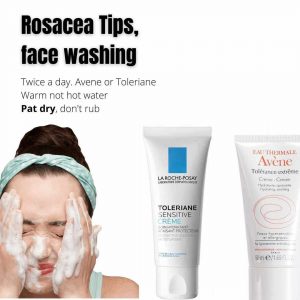
What are some simple washing tips for rosacea skin types?
Adapt these hints based on your routine-
- Use lukewarm water, never hot. Heat can irritate your skin.
- Most importantly keep your showers to less than 3 minutes.
- Wash with your fingers and hands, not a brush. You do not need rotating brushes/Clarisonic, nor potentially abrasive brushes. Simple is best.
- To dry, blot with a thick pile cotton towel, don’t rub. Minimise trauma.
- Wait till your skin dries before applying any topicals.
- Re-apply moisturizer if you are using actives (wait 30 minutes)
What is the best moisturizer for rosacea skin?
You are better off using a medical grade moisturizer if you have rosacea or other causes of sensitive skin.
As a guide, La Roche Posay, Avene, Cerave, & Cetaphil make special ranges for sensitive skin. The Toleriane & Cicaplast range from LRP are cost effective options.

View our Treatment Gallery
How should you approach skin care if you have rosacea?
One word- cautiously. Rosacea patients have extra-sensitive skin. This means you can not afford to ‘try’ things out, because chances are you will get a reaction. As a rule you consider the use of calming lotions & anti-inflammatory topicals. Consider-
- Niacinamide 5-10% in a good formulation. Vitamin B3 can reduce inflammation, redness as well as improve your skin’s barrier function.
- Azelaic acid 10-20%, azelaic acid can reduce inflammation, acne, calm sensitive skin as well as reduce pigmentation. It is relatively gentle on the skin.
- Botanicals such as green tea can reduce inflammation & protect skin from UV induced damage.
- Tocopherol or vitamin E is a fat soluble, banal skin care vitamin. It is a powerful antioxidant that does not irritate skin.
- Skin care acids are double edge topicals, on one hand they can be useful to decrease inflammation (very low dose salicylic acid – around 0.5 to 2%). BHA can also reduce scale formation in cases of rosacea seb dermatitis overlap, however AHAs such as glycolic acid can be pro-inflammatory. If in doubt, test patch.
You may be better off under the guidance of a skincare professional or a medical dermatologist if you have uber sensitive skin. If in doubt, use a low concentration on a area in front or one ear *2 by 1 cm ‘spot test’. If your skin reacts you most likely would have an irritant reaction. True skin allergies are rare, but can be investigated with patch testing.
Why are skin pores larger in rosacea patients (& what you can do)?
Skin inflammation from rosacea makes pores appear larger. This is most commonly seen on the cheeks, forehead, & nose. Treat the inflammation, & stimulate collagen to support the pores means no more enlarged pores. A few pointers-
- Niacinamide 10% is anti-inflammatory. Use up to twice a day on affected areas. Formulations really do matter. Aspect Dr, The Formulated, Medik 8
- Azelaic acid 10-20% is anti-inflammatory. Use up to twice a day. Azclear is a good, cost effective brand.
- Botanicals can help, aloe vera reported as an anti-inflammatory.
- A medical dermatologist can prescribe anti-inflammatories to reduce flare ups.
- Enlarged pores can be treated with lasers & light based systems, these include vascular, fractional & pico laser as well as thermomechanical systems like Tixel. Consult my nurses @cliniccutis for more information.
Version 2 of rosacea management via stories, tap for the algorithm as to how to manage rosacea. This will be part of my pre-consultation process once I iron out the bugs. Please provide feedback🙏🏼
The more skill sets one learns, the bigger the yellow bit on the pie chart
Vascular lasers are one of the most commonly utilised lasers in #dermatology
Spent the last 6 months batching together skincare products for a CURATED skincare shop. Will be launched in 4 weeks. I realise how confusing it can be with literally thousands of products & infinite combinations 🤫🤷🏻♀️
.
🔬Skin science: Rosacea skincare is tricky. Start slow, titrate, analyse what you can tolerate & what flare up your skin
.
☀️Sunscreen is essential. Most will tolerate LRP Anthelios, either chemical or hybrid physical (depending on which country you live in). Invisible Zinc if you want pure physical SPF
.
👊Actives: Stick with hyaluronic acid, niacinamide, & azelaic acid
.
😳What about retinol/retinoids? It is not an absolute contraindication, but you will require care & titration
.
🔫What about procedures? Lasers over chemical peels. Lasers include vascular laser, QSL, #pico, #dermaltoning, laser genesis. If you want #Fraxel or ablative CO2, cover with doxycycline for 3 weeks, add vascular laser for rebound redness
.
🎬Action: Book a consult with my colleagues & clinical team @cliniccutis
.
👍🏻Management & options: Surf the algorithm in the stories. This is version 1.2, still requires more branches, feedback will be great (including any bugs you have found). I have based answers on probability not possibility, taking into account the time vs completion rate to maximise information & minimise drop-outs. As the algorithms evolve I will allow for ‘skip’ segments to allow faster completion times, or more detail for those wanting it
.
😎Davin Lim
Dermatologist
Brisbane🇦🇺
@cliniccutis
.
#drdavinlim #drdavinlim #skin #skincare #rosacea #rosaceaskin #rosaceatreatment
#rosaceaskincare #rosaceasupport #rosaceacommunity #rosaceacure #dermatologist
#dermatology #dermatologistbrisbane #rosaceatips #skinrejuvenation #rosaceaskinrejuvenation #cutisclinic
.
.
👉Skin care: bad news if the only thing you got is #skincare. The biggest change to skin health is to reduce inflammation. Sometimes backing off skincare can give huge gains- think #rosacea & sensitive skin
.
🌞Lifestyle choice: a big gain here, especially if you suffer pigmentation such as #melsama. Photoprotection & #sunscreen can improve pigment by over 50%, avoidance of flare factors (within reason) improves rosacea
.
👶Genetics: can be a plus or a minus. Ethnic skin? #PIH an issue, flipside? Probably stimulate #collagen easier. Thank or cuss your mum-dad for genes
.
💉🔫🔪Procedures: can change skin health & texture / skin quality. Everything from enlarged pores, pigment, redness & more. The holy grail are cases such as #darkcircles, constitutional pigmentation, pigmentary demarcation lines , dermal #melasma & stretch marks
.
😎Davin Lim
Dermatologist
Brisbane🇦🇺
.
#skincare #skincaretips #skinhealth #skincarescience #instaskincare #cosmeticinjectables #laserrejuvenation #healthyskin #skincareroutine #skincarejunkie
.
.
🔬Skin Science: Vascular lasers target haemoglobin. The bigger the number the deeper the penetration. My most frequently used wavelengths include 595 & 1064, occasionally 755 alex
.
.
👉👍🏻Most Common Conditions: #rosacea, post acne marks - PIE/ post inflammatory erythema, active inflammatory #acne (adjunct to medical), teles, #spidernaevi, vascular birthmarks including #portwinestains, post surgical redness, #stretchmarks (red-early), red bits of #poikiloderma & vascular component of #melasma. In general most red conditions can be improved-treated with vascular lasers
.
.
💯Skincare: Is important for prevention. Sunscreen can help with many red conditions including rosacea, melasma, PIE from acne & even photosensitive seb derm. Simple cleansers & moisturizer best for rosacea. I don’t use topicals such as brimonidine - #Mirvaso as the rebound rate is too high. Usual anti-inflammatory such as #azelaicacid as adjunctive management in some cases
.
.
🎬Action: Book with my clinical team @cliniccutis. They will find a solution for your redness. We have 5 vascular energy devices covering 595 to 1064 nm plus IPL/BBL, hence in the majority of cases redness can be easily treated ! I am happy to see complex or resistant cases including birthmarks
.
.
😎Dr Davin Lim
Brisbane, 🇦🇺
@drdavinlim
@cliniccutis
#skinscience #beautyscience #dermatology #dermatologist #brisbanedermatologist #laserrejuvenation #drdavinlim #davinlim #rosaceatips #rosaceaskincare #rosacealaser
.
.
🔬Skin Science: Niacinamide has many actions in the skin, the anti-inflammatory effects are most useful. This compound can also aid in restoring barrier function, reduces UV immune suppression, as well as decrease sebum production. It has weak pigment reducing effects. Retinol & #retinoids increase cell turnover, increases epidermal & dermal thickness, & acts as a chemical exfoliant. Retinoid side effects are often rate limiting. A complementary combination involves the use of Vitamin A namely retinol & vitamin B, namely niacinamide
.
.
🙄👍🏻Sensitive skin + Rosacea: For my rosacea patients, I normally start you on niacinamide before other topicals, as this compound is anti-inflammatory. B3 can be combined with other topicals as long as the pH is over 5.0. Add a good retinol formulation after 4 weeks, start every second night & increase as tolerated. If you have normal skin, start with retinol followed by niacinamide, & lastly #ascorbicacid
.
.
😎Dr Davin Lim, Dermatologist
Brisbane. Australia🇦🇺
#dermatologist #brisbanedermatologist #skincare #skincaretips #skincarescience #instaskincare #bestskincare #drdavinlim #davinlim #skincareshop #rosacea #rosaceatips #rosaceaskincare #niacinamide
.
.
Disclaimer: My work is purely procedural however for an in-depth analysis of topicals, discuss your concerns with my clinical team @cliniccutis
What is the best makeup for rosacea prone skin?
Most skin care experts recommend mineral makeup. This formulation is talc & paraben free. Some make up colours include a tiny bit of green as this colour spectrum can potentially hide the red from rosacea.
For colour matching & coverage, you are best advised to see a good make up artist for tips and tricks, over a dermatologist.
For eye make up, consider extra-gentle routines. Eyes are sensitive to begin with, and if yours have signs and symptoms of ocular rosacea, it’s especially important to be extra careful. Select products designed for sensitive eyes that have been ophthalmologist tested — preferably allergy- tested, fragrance-free formulas may be ideal. Mascara and eyeliner should be easy to apply and remove without pulling or tugging on the eyes. Look for mascara formulas that can be gently removed by simply rinsing with warm water. Mineral powder eye shadow may be the perfect choice for eyes susceptible to rosacea symptoms. Neutral colors, both in shadow and eye pencils, may also be less irritating than strong jewel tones since they have less pigment.
Can I use retinol if I have rosacea?
Retinol can be tolerated in some patients with rosacea. As a rule you should consider a good low dose formulation of retinol (over retinoic acid or retinaldehyde). Murad makes good, low irritant formulations. The Ordinary is not a good choice in the context of rosacea or if you have sensitive skin.
- Consider initiating treatment when your rosacea cycle is not as inflamed.
- Start off every second night
- Apply a moisturizer 30 minutes before retinol
- Start with a 0.5% formulation
- If you have sensitive skin, skip a day…or a week
- Increase as tolerated
- If you have inflammation, use niacinamide or azelaic acid to reduce redness
- Increase your concentration to 1.0% after 3-4 months
- Listen to your skin, if required give retinoids a break
- Be guided by your dermatologist, they may give you a very short course of anti-inflammatories to get you back on track
With correct & cautious use, retinol can be used intermittently by most rosacea patients. Should you require guidance please see my clinical staff at Clinic Cutis. The same applies for prescription retinoids such as Retreive. In this context, skin irritation is much more common, hence why you should start with retinols.

*Disclaimer: My work in the context of rosacea is eneritey procedural, namely I employ vascular lasers for recalcitrant inflammatory or telangiectatic rosacea, or ablative lasers for the management of end stage phyma.
What prescription medications are frequently used for treating rosacea?
Dermatologists will often prescribe medications to help control rosacea that does not improve with conventional medications & lifestyle changes. These include-
Topical creams, gels and lotions. Rozex is one of the most commonly prescribed gels. This has metronidazole, whilst Finacea is azelaic acid. Other creams include Soolantra or ivermectin topically. This targets mites called Demodex that live on the skin. Other topicals include brimonidine & sulfur based compounded creams. Another solution contains sodium sulfacetamide, sulphur, & salicylic acid. This can be used as a face wash. Short contact, short term pulsed cs or anti-inflammatories can be combined with other creams.
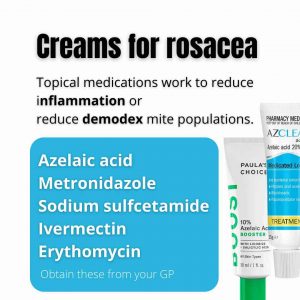
Tablets including doxycycline, EES, tetracyclines, lymecin, & oral isotretinoin. These work by modulation of inflammation. Micro-Botox or botulinum toxin can be considered in recalcitrant cases.
Flushing and blushing can be treated with beta-blockers including propranolol or alpha adrenergics. Mirvasso or brimonidine topical can be effective in the extreme minority of patients.

What anti-aging procedures should you consider if you have rosacea prone skin?
It is important to approach skin care analytically with thought, precision & purpose. This is especially important for rosacea patients as the majority of strong anti-aging products like retinoids, ascorbic acid & skincare acids can flare up rosacea.

As suggested, start with a good formulation of Niacinamide, then add an active every 2 to 3 months as tolerated. The next can be retinol at 0.5%. You can even dilute this with half a pea application of retinol on one finger tip & moisturizer on the other. This can give you an approximate dilution of 0.25%.
Lasers & light based rejuvenation procedures are preferred over chemical peels purely because light can reduce inflammation, while peels (even enzyme peels) have the potential to flare up rosacea patients. Here are a few sensible skin rejuvenation produces to consider in rosacea patients-
- Laser Genesis with the LP Nd Yag Vascular Laser: this can reduce redness & at the same time reduce skin sensitivity & burning. Over time it builds collagen, reduces pore sizing.
- Vascular 595 VBeam Perfecta/Prima; the go to laser if you have rosacea. This can also improve skin texture with continued use (3-6 sessions)
- 1927 Diode lasers such as Clear And Brilliant can rejuvenate your skin with minimal risks of flare ups.
- Pico Toning
- Dermal Toning
- Tixel; is a thermomechanical device that is relatively new. It can treat wrinkles, pores as well as recalcitrant rosacea (often in combination with BTX)
- Aquagold Nano with BTX; for refractory rosacea
What are the finer points of rosacea management?
Rosacea is an adjustment disorder. You will adjust to this. The more analytical you are, the faster you will figure it out.
Every case is different, you will have a very own blueprint of flare factors, skin irritants, & exacerbating factors. The flipside is that you will have a unique set of plans to calm your skin down. This can include foods, de-stressing, topicals, orals, & even laser treatments.
The way you figure it out is like detective work, the more meticulous you are, the more you pay attention to the smaller details, the more accurate your mapping. This way you can understand what flares up your condition, & conversely what works to calm it down.
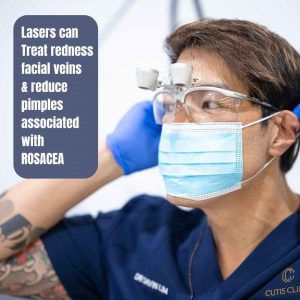
Keeping a simple rosacea diary, food diary & sequence of recording of events based upon observations & photographic documentation will help.
When you add, subtract or alter things, do it step by step. For example, don’t change your entire skin care range at the same time. Alter one small aspect, a cleaner for example. This gives you a better analytical profile of changes.
Who to see to help you figure it out?
Discuss options with your medical dermatologist. If you are after a directed skin care & rejuvenation program, book an appointment with my nurses at Clinic Cutis. They will guide you as to product use, lasers, & rejuvenation procedures.
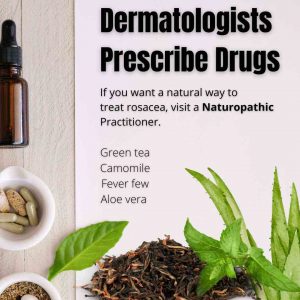
Disclaimer: My work is entirely procedural, I do not do skincare consultations, nor do I practice medical dermatology. In the context of rosacea, my skill sets are with lasers including vascular lasers for refractory rosacea & ablative treatment of end-stage rhinophyma. My colleagues can assist with medical management.
Davin’s Viewpoint on Managing Rosacea
The more you pay attention to the details, the more you understand your skin. The most important aspect of skin care is to really understand your skin’s threshold for skin irritation, irrespective of disease. In the context of rosacea, this irritation threshold is markedly less than with normal skin types. Put simply, rosacea patients do not have the luxury of time to ‘try’ products. Skin irritation in normal individuals may last a day or so, for rosacea patients, inflammation may last weeks or months. On this basis, consider seeing a skin care professional like an aesthetician, dermal therapist, dermatology nurse or a medical dermatologist for guidance. Finding your blueprint will make skin care a lot easier.
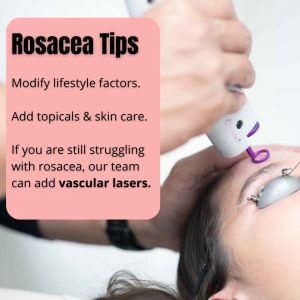
Above all, keep things really simple. This includes cleansers, moisturizer, as well as active skin care. Under guidance, most patients can tolerate low dose formulation of retinol, and some even an attenuated routine with retinoids. To start off with, initiate low irritant options including niacinamide, or even azelaic acid. As always, formulations matter, this is especially important in rosacea patients.

Disclaimer: My role in the management of rosacea is a very narrow one, namely my job is procedural. I treat end stage rosacea including phyma patients. I also employ lasers to reduce inflammation & redness. Lasers are not monotherapy. Ideally you should be under the guidance of a medical dermatologist as treatments with topicals & orals are frequently needed. Skin irritation & allergic reactions are also in the realm of medical dermatology.

